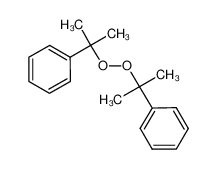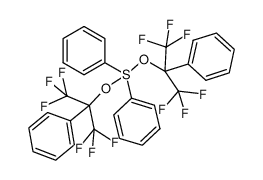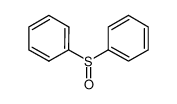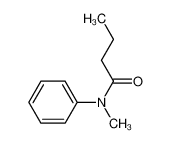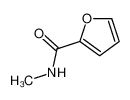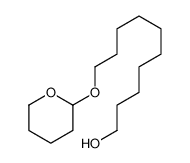1.Identification
1.1 GHS Product identifier
| Product name | Dicumyl Peroxide |
|---|
1.2 Other means of identification
| Product number | - |
|---|---|
| Other names | Bis(1-methyl-1-phenylethyl)peroxide |
1.3 Recommended use of the chemical and restrictions on use
| Identified uses | For industry use only. Process regulators,Viscosity adjustors |
|---|---|
| Uses advised against | no data available |
1.4 Supplier's details
| Company | MOLBASE (Shanghai) Biotechnology Co., Ltd. |
|---|---|
| Address | Floor 4 & 5, Building 12, No. 1001 North Qinzhou Road, Xuhui District, Shanghai, China |
| Telephone | +86(21)64956998 |
| Fax | +86(21)54365166 |
1.5 Emergency phone number
| Emergency phone number | +86-400-6021-666 |
|---|---|
| Service hours | Monday to Friday, 9am-5pm (Standard time zone: UTC/GMT +8 hours). |
2.Hazard identification
2.1 Classification of the substance or mixture
Organic peroxides, Type F
Skin irritation, Category 2
Eye irritation, Category 2
Hazardous to the aquatic environment, long-term (Chronic) - Category Chronic 2
2.2 GHS label elements, including precautionary statements
| Pictogram(s) |    |
|---|---|
| Signal word | Warning |
| Hazard statement(s) | H242 Heating may cause a fire H315 Causes skin irritation H319 Causes serious eye irritation H411 Toxic to aquatic life with long lasting effects |
| Precautionary statement(s) | |
| Prevention | P210 Keep away from heat, hot surfaces, sparks, open flames and other ignition sources. No smoking. P234 Keep only in original packaging. P235 Keep cool. P240 Ground and bond container and receiving equipment. P280 Wear protective gloves/protective clothing/eye protection/face protection. P264 Wash ... thoroughly after handling. P273 Avoid release to the environment. |
| Response | P370+P378 In case of fire: Use ... to extinguish. P302+P352 IF ON SKIN: Wash with plenty of water/... P321 Specific treatment (see ... on this label). P332+P313 If skin irritation occurs: Get medical advice/attention. P362+P364 Take off contaminated clothing and wash it before reuse. P305+P351+P338 IF IN EYES: Rinse cautiously with water for several minutes. Remove contact lenses, if present and easy to do. Continue rinsing. P337+P313 If eye irritation persists: Get medical advice/attention. P391 Collect spillage. |
| Storage | P403 Store in a well-ventilated place. P410 Protect from sunlight. P411 Store at temperatures not exceeding …°C/…°F. P420 Store separately. |
| Disposal | P501 Dispose of contents/container to ... |
2.3 Other hazards which do not result in classification
none
3.Composition/information on ingredients
3.1 Substances
| Chemical name | Common names and synonyms | CAS number | EC number | Concentration |
|---|---|---|---|---|
| Dicumyl Peroxide | Dicumyl Peroxide | 80-43-3 | none | 100% |
4.First-aid measures
4.1 Description of necessary first-aid measures
General advice
Consult a physician. Show this safety data sheet to the doctor in attendance.
If inhaled
Fresh air, rest.
In case of skin contact
First rinse with plenty of water for at least 15 minutes, then remove contaminated clothes and rinse again.
In case of eye contact
First rinse with plenty of water for several minutes (remove contact lenses if easily possible), then refer for medical attention.
If swallowed
Rinse mouth. Give one or two glasses of water to drink. Refer for medical attention .
4.2 Most important symptoms/effects, acute and delayed
Excerpt from ERG Guide 145 [Organic Peroxides (Heat and Contamination Sensitive)]: Fire may produce irritating, corrosive and/or toxic gases. Ingestion or contact (skin, eyes) with substance may cause severe injury or burns. Runoff from fire control or dilution water may cause pollution. (ERG, 2016)
4.3 Indication of immediate medical attention and special treatment needed, if necessary
For immediate first aid: Ensure that adequate decontamination has been carried out. If victim is not breathing, start artificial respiration, preferably with a demand-valve resuscitator, bag-valve-mask device, or pocket mask as trained. Perform CPR if necessary. Immediately flush contaminated eyes with gently flowing water. Do not induce vomiting. If vomiting occurs, lean patient forward or place on left side (head-down position, if possible) to maintain an open airway and prevent aspiration. Keep victim quiet and maintain normal body temperature. Obtain medical attention. /Organic peroxides/
5.Fire-fighting measures
5.1 Extinguishing media
Suitable extinguishing media
Use water in flooding quantities as fog. Cool all affected containers with flooding quantities of water. Apply water from as far a distance as possible. Use "alcohol" foam, carbon dioxide, or dry chemical. If the material is on fire, or involved in fire, evacuate for a radius of 2500 feet. /Dicumyl peroxide, (50% peroxide) or dicumyl peroxide, dry/
5.2 Specific hazards arising from the chemical
Excerpt from ERG Guide 145 [Organic Peroxides (Heat and Contamination Sensitive)]: May explode from heat or contamination. May ignite combustibles (wood, paper, oil, clothing, etc.). May be ignited by heat, sparks or flames. May burn rapidly with flare-burning effect. Containers may explode when heated. Runoff may create fire or explosion hazard. (ERG, 2016)
5.3 Special protective actions for fire-fighters
Wear self-contained breathing apparatus for firefighting if necessary.
6.Accidental release measures
6.1 Personal precautions, protective equipment and emergency procedures
Use personal protective equipment. Avoid dust formation. Avoid breathing vapours, mist or gas. Ensure adequate ventilation. Evacuate personnel to safe areas. Avoid breathing dust. For personal protection see section 8.
6.2 Environmental precautions
Remove all ignition sources. Sweep spilled substance into covered containers. If appropriate, moisten first to prevent dusting. Carefully collect remainder. Then store and dispose of according to local regulations. Do NOT let this chemical enter the environment. Personal protection: P2 filter respirator for harmful particles.
6.3 Methods and materials for containment and cleaning up
Spills should be cleaned up promptly using non-sparking tools and an inert moist diluent such as vermiculite or sand. Sweepings may be placed in open containers or polyethylene bags and the area washed with water and detergent. /Organic peroxides/
7.Handling and storage
7.1 Precautions for safe handling
Avoid contact with skin and eyes. Avoid formation of dust and aerosols. Avoid exposure - obtain special instructions before use.Provide appropriate exhaust ventilation at places where dust is formed. For precautions see section 2.2.
7.2 Conditions for safe storage, including any incompatibilities
Fireproof. Separated from combustible substances, reducing agents, strong oxidants, strong acids, bases and heavy metals. Cooled. Keep in the dark. Well closed. Keep under inert gas.Safety measures for organic peroxides are dictated by their individual sensitivity to heat, friction, shock, and contamination. ... Peroxides should be stored in their original containers in a ventilated place separated from other materials and protected from flame, static electricity, sparks, sources of heat (for example steam-pipes, radiators or direct sunlight), shock, or friction. ... The max recommended storage temp is 38°C or less. /Organic peroxides/
8.Exposure controls/personal protection
8.1 Control parameters
Occupational Exposure limit values
no data available
Biological limit values
no data available
8.2 Appropriate engineering controls
Handle in accordance with good industrial hygiene and safety practice. Wash hands before breaks and at the end of workday.
8.3 Individual protection measures, such as personal protective equipment (PPE)
Eye/face protection
Safety glasses with side-shields conforming to EN166. Use equipment for eye protection tested and approved under appropriate government standards such as NIOSH (US) or EN 166(EU).
Skin protection
Wear impervious clothing. The type of protective equipment must be selected according to the concentration and amount of the dangerous substance at the specific workplace. Handle with gloves. Gloves must be inspected prior to use. Use proper glove removal technique(without touching glove's outer surface) to avoid skin contact with this product. Dispose of contaminated gloves after use in accordance with applicable laws and good laboratory practices. Wash and dry hands. The selected protective gloves have to satisfy the specifications of EU Directive 89/686/EEC and the standard EN 374 derived from it.
Respiratory protection
Wear dust mask when handling large quantities.
Thermal hazards
no data available
9.Physical and chemical properties
| Physical state | white diamond crystallization |
|---|---|
| Colour | Pale yellow to white granular solid |
| Odour | no data available |
| Melting point/ freezing point | 38-41ºC |
| Boiling point or initial boiling point and boiling range | 130ºC |
| Flammability | Combustible. |
| Lower and upper explosion limit / flammability limit | no data available |
| Flash point | > 110ºC |
| Auto-ignition temperature | no data available |
| Decomposition temperature | 130°C |
| pH | no data available |
| Kinematic viscosity | no data available |
| Solubility | In water:insoluble |
| Partition coefficient n-octanol/water (log value) | log Kow = 5.50 |
| Vapour pressure | 15.4 mm Hg ( 38 °C) |
| Density and/or relative density | 1.56g/mLat 25°C(lit.) |
| Relative vapour density | 9.3 (vs air) |
| Particle characteristics | no data available |
10.Stability and reactivity
10.1 Reactivity
no data available
10.2 Chemical stability
Very insensitive to shock and friction.
10.3 Possibility of hazardous reactions
Ignites slowly, burns vigorously.The explosive instability of the lower dialkyl peroxides (e.g., dimethyl peroxide) and 1,1-bis-peroxides decreases rapidly with increasing chain length and degree of branching, the di-tert-alkyl derivatives being amongst the most stable class of peroxides. Though many 1,1-bis-peroxides have been reported, few have been purified because of the higher explosion hazards compared with the monofunctional peroxides. It is unlikely that this derivative would be particularly unstable compared to other peroxides in its class [Bretherick 2nd ed., p 44 1979].
10.4 Conditions to avoid
no data available
10.5 Incompatible materials
Upon contact with reducing materials, such as organic matter or thiocyanates, an explosion can occur. /Organic peroxides/
10.6 Hazardous decomposition products
When heated to decomp it emits acrid smoke and irritating fumes.
11.Toxicological information
Acute toxicity
- Oral: no data available
- Inhalation: no data available
- Dermal: no data available
Skin corrosion/irritation
no data available
Serious eye damage/irritation
no data available
Respiratory or skin sensitization
no data available
Germ cell mutagenicity
no data available
Carcinogenicity
no data available
Reproductive toxicity
no data available
STOT-single exposure
no data available
STOT-repeated exposure
no data available
Aspiration hazard
no data available
12.Ecological information
12.1 Toxicity
- Toxicity to fish: no data available
- Toxicity to daphnia and other aquatic invertebrates: no data available
- Toxicity to algae: no data available
- Toxicity to microorganisms: no data available
12.2 Persistence and degradability
Using a standard BOD dilution technique and a sludge inoculum, 0% of the theoretical BOD was observed for dicumyl peroxide over a 4 week incubation period(1).
12.3 Bioaccumulative potential
Experimental BCF values in the range of 137-1,470 and 181-667 were measured in carp exposed to 10 ug/l and 1 ug/l of dicumyl peroxide over an 8 week incubation period(1). According to a classification scheme(2), bioconcentration in aquatic organisms is considered high based upon these BCF values.
12.4 Mobility in soil
The Koc of dicumyl peroxide is estimated as approximately 23,400(SRC), using a measured log Kow of 5.5(1) and a regression-derived equation(2,SRC). According to a recommended classification scheme(3), this estimated Koc value suggests that dicumyl peroxide will have no mobility in soil(SRC).
12.5 Other adverse effects
no data available
13.Disposal considerations
13.1 Disposal methods
Product
The material can be disposed of by removal to a licensed chemical destruction plant or by controlled incineration with flue gas scrubbing. Do not contaminate water, foodstuffs, feed or seed by storage or disposal. Do not discharge to sewer systems.
Contaminated packaging
Containers can be triply rinsed (or equivalent) and offered for recycling or reconditioning. Alternatively, the packaging can be punctured to make it unusable for other purposes and then be disposed of in a sanitary landfill. Controlled incineration with flue gas scrubbing is possible for combustible packaging materials.
14.Transport information
14.1 UN Number
| ADR/RID: UN3110 | IMDG: UN3110 | IATA: UN3110 |
14.2 UN Proper Shipping Name
| ADR/RID: ORGANIC PEROXIDE TYPE F, SOLID |
| IMDG: ORGANIC PEROXIDE TYPE F, SOLID |
| IATA: ORGANIC PEROXIDE TYPE F, SOLID |
14.3 Transport hazard class(es)
| ADR/RID: 5.2 | IMDG: 5.2 | IATA: 5.2 |
14.4 Packing group, if applicable
| ADR/RID: II | IMDG: II | IATA: II |
14.5 Environmental hazards
| ADR/RID: yes | IMDG: yes | IATA: yes |
14.6 Special precautions for user
no data available
14.7 Transport in bulk according to Annex II of MARPOL 73/78 and the IBC Code
no data available
15.Regulatory information
15.1 Safety, health and environmental regulations specific for the product in question
| Chemical name | Common names and synonyms | CAS number | EC number |
|---|---|---|---|
| Dicumyl Peroxide | Dicumyl Peroxide | 80-43-3 | none |
| European Inventory of Existing Commercial Chemical Substances (EINECS) | Listed. | ||
| EC Inventory | Listed. | ||
| United States Toxic Substances Control Act (TSCA) Inventory | Listed. | ||
| China Catalog of Hazardous chemicals 2015 | Listed. | ||
| New Zealand Inventory of Chemicals (NZIoC) | Listed. | ||
| Philippines Inventory of Chemicals and Chemical Substances (PICCS) | Listed. | ||
| Vietnam National Chemical Inventory | Listed. | ||
| Chinese Chemical Inventory of Existing Chemical Substances (China IECSC) | Listed. | ||
16.Other information
Information on revision
| Creation Date | Aug 17, 2017 |
|---|---|
| Revision Date | Aug 17, 2017 |
Abbreviations and acronyms
- CAS: Chemical Abstracts Service
- ADR: European Agreement concerning the International Carriage of Dangerous Goods by Road
- RID: Regulation concerning the International Carriage of Dangerous Goods by Rail
- IMDG: International Maritime Dangerous Goods
- IATA: International Air Transportation Association
- TWA: Time Weighted Average
- STEL: Short term exposure limit
- LC50: Lethal Concentration 50%
- LD50: Lethal Dose 50%
- EC50: Effective Concentration 50%
References
- IPCS - The International Chemical Safety Cards (ICSC), website: http://www.ilo.org/dyn/icsc/showcard.home
- HSDB - Hazardous Substances Data Bank, website: https://toxnet.nlm.nih.gov/newtoxnet/hsdb.htm
- IARC - International Agency for Research on Cancer, website: http://www.iarc.fr/
- eChemPortal - The Global Portal to Information on Chemical Substances by OECD, website: http://www.echemportal.org/echemportal/index?pageID=0&request_locale=en
- CAMEO Chemicals, website: http://cameochemicals.noaa.gov/search/simple
- ChemIDplus, website: http://chem.sis.nlm.nih.gov/chemidplus/chemidlite.jsp
- ERG - Emergency Response Guidebook by U.S. Department of Transportation, website: http://www.phmsa.dot.gov/hazmat/library/erg
- Germany GESTIS-database on hazard substance, website: http://www.dguv.de/ifa/gestis/gestis-stoffdatenbank/index-2.jsp
- ECHA - European Chemicals Agency, website: https://echa.europa.eu/
